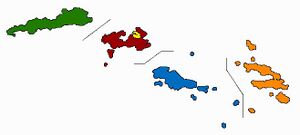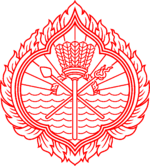Kapuku: Difference between revisions
mNo edit summary |
No edit summary |
||
| Line 18: | Line 18: | ||
|national_languages = [[Kapukan Language|Kapukan]], [[Zhenian language|Zhenian]] | |national_languages = [[Kapukan Language|Kapukan]], [[Zhenian language|Zhenian]] | ||
|ethnic_groups = 78.1% {{wp|Native Hawaiians|Kapukan}}<br>10.1% Mixed (Zhenian+Kapukan)<br>9.5% [[Zhenia|Zhenian]]<br>2.3% Other<br> | |ethnic_groups = 78.1% {{wp|Native Hawaiians|Kapukan}}<br>10.1% Mixed (Zhenian+Kapukan)<br>9.5% [[Zhenia|Zhenian]]<br>2.3% Other<br> | ||
|religion = | |religion = 69.6% [[Haipule]]<br>15.1 [[Wuism]]<br>9.8% {{wp|Atheism|None}}<br>5.5% Other | ||
|demonym = Kapukan | |demonym = Kapukan | ||
|government_type = [https://en.wikipedia.org/wiki/Constitutional_monarchy Constitutional Monarchy] | |government_type = [https://en.wikipedia.org/wiki/Constitutional_monarchy Constitutional Monarchy] | ||
Revision as of 16:32, 7 April 2020
This article is incomplete because it is pending further input from participants, or it is a work-in-progress by one author. Please comment on this article's talk page to share your input, comments and questions. Note: To contribute to this article, you may need to seek help from the author(s) of this page. |
Kingdom of Kapuku ㅏㅜㅍㅜㄴㅣ ㅋㅏㅍㅜㅋㅜ | |
|---|---|
| Motto: "ㅗㅋㅏ ㄴㅏㄴㅣ ㅁㅔ ㅋㅔ ㅋㅜㅣㅋㅏㅎㅣ" | |
| Anthem: "Kapuku Oh Kapuku" | |
 Map of Kapuku | |
| Capital and largest city | Lono |
| Official languages | Kapukan |
| Recognised national languages | Kapukan, Zhenian |
| Ethnic groups | 78.1% Kapukan 10.1% Mixed (Zhenian+Kapukan) 9.5% Zhenian 2.3% Other |
| Religion | 69.6% Haipule 15.1 Wuism 9.8% None 5.5% Other |
| Demonym(s) | Kapukan |
| Government | Constitutional Monarchy |
• King | Keaka Mulopi II |
• Prime Minister | Kaui Inoke |
• President of Legislature | Kaipo Aino |
| Legislature | House of Nobles House of Representatives |
| Establishment | |
| 392 AC | |
| 508 AC | |
| 1057 AC | |
• Shindan Administration | 1130 AC |
• Annexation by Zhenia | 1529 AC |
• Liberation From Zhenia | 1534 AC |
| 1536 AC | |
| Area | |
• Total | 258,147 km2 (99,671 sq mi) |
| Population | |
• 2020 estimate | 7,098,743 |
• 2011 census | 6,873,173 |
| GDP (nominal) | 2016 estimate |
• Total | $213 Billion |
• Per capita | $41,428 |
| HDI (2020) | 0.844 very high |
| Currency | Kala (KLA) |
| Time zone | Kapuku Standard Time |
| Date format | YYYY/MM/DD |
| Calling code | +18 |
| Internet TLD | .kp |
Kapuku (Kapukan: ㅋㅏㅍㅜㅋㅜ), officially the Kingdom of Kapuku (Kapukan: ㅏㅜㅍㅜㄴㅣ ㅋㅏㅍㅜㅋㅜ), is a kingdom situated in the Kapukan Archipelago. Located in the middle of the Pacific Ocean, the nation has no land borders with any other nation and comprises of four major islands - Ulukau, Limoni, Hulawa, and Haumea - alongside smaller islands that together form the archipelago. With the nation itself being home to around 7 million residents, its capital and largest city is Lono.
Archaeological evidence show that the Kapukan Archipelago was first settled in the 300s AC by South Sea Islanders. The early Kingdom of Limoni united the archipelago for over a century until the death of king Kei Kealoha and the division of the islands into four separate kingdoms. These four kingdoms went on to fight for centuries in what is known as the Warring Period, an era that also saw great cultural and military progress in the archipelago. In 1057 AC, Meakhani united the islands but they soon were ravaged due to disease brought from Zhenian traders. The islands soon collapsed and became a tributary of the Shindan dynasty and later a crown dependency of the Empire of Zhenia. While the islands were annexed into Zhenia shortly before the Second Great War, a rebellion that initiated in 1533 AC ultimately resulted in Kapukan independence three years later. An absolute monarchy ruled the nation after its independence until 1534 AC, when a coup d'etat overthrew the government and created a constitutional monarchy that lasts to this day.
Today, Kapuku is a small developed nation and home to one of the largest economies in the mid-Pacific region. It is also known for its highly-developed technology sector, which makes up about 30% of the economy, as well as its rich and unique culture, which makes it a popular tourist destination with stunning landscape that has received high media coverage in recent years.
Etymology
The name "Kapuku" is derived from two words, "Kapu" and "Kū". Kapu is an ancient set of traditions and guidelines used by the people of Kapuku for hundreds of years. "Kū" means war, giving a name that means something similair to "War with rules" which gives insight into the foundation and culture of Kapuku.
History
First Settlement
The first settlers of Kapuku came from the continent of Tarsis in the modern day nation of Zhenia. These settlers (Known as the Kapukans) Went on to settle vast amounts of islands and lands in and around Tarsis. The people group traveled the oceans in canoes, using only the stars and currents as guides to where they were going. This form of travel is known as Kumu and is an oral tradition that only Kupukans possess. One of their most important settlements was the Kapukan Archipelago. The first kingdom in what is today Kapuku was the great Kingdom of Limoni The Kingdom of Limoni was founded in 392 AC. Being the only inhabited island in Kapuku thus far, they continued to settle further into the islands of Ulukau, Hulawa, and Haumea. The Kingdom of Limoni also founded the great city of Lono which became a center for knowledge and culture. Instability came the death of Kei Kealoha as his four sons fought over control over the islands. The fight continued for 2 years until the four sons came to an agreement in 508 AC, each one of them would have control over one island, creating a total of four kingdoms.
The Four Kingdoms
From 506 AC to 1057 AC, the kingdoms of Kapuku were constantly at war. While many people were killed from this period, it also brought advancements in technology such as. larger boats and armor. Without this period, unification would have never been possible for Kapuku. This time period also brought early philosophy and military tactics to Kapuku. Religion and culture advanced greatly during this time period making some give it the nickname of "ㅋㅔ ㅋㅏㅜㅏ" or "The Advancement". In 916, there were four kingdoms, Ulukau, Limoni, Hulawa, and Huamea. All of the kingdoms fought and no real advancements were made until the year 731 AC. In this year, Queen Lilioukeana of Hulawa sent her army to the island of Second Kingdom of Limoni. After learning from past mistakes, the Kingdom of Ulukau built larger canoes to hold more soldiers. They also introduced the first pieces of Kapukan armor which were helmets made from the bones of animals and in some cases, even humans. The soldiers were able to capture Lono city and burned most of it. This war was the first to see any modern technology used in Kapuku.
Meakhani's Kingdom
Zhenian Rule
World War Two
The Reformation
The Contemporary Period
Geography
Administrative divisions
Kapuku is split into a total of five administrative divisions. They are, Ulukau, Limoni, Lono, Hulawa, and Huamea. Each division is in charge of education, health, etc. Because of this, some slight diferences in laws exist between divisions. Each division is further split into Moku which each have local Ali'lis. Each division has a local capital which is the largest city in each division.

Climate
Kapuku is split into about 5 climate zones. The coasts of Kapuku see mostly rainforest and small areas of monsoon type climates. Further inland, mainly oceanic and mediterranean climates are present. Around Kapuku's many volcanos, tundra-like climates can be observed. Temperatures in Kapuku rarely exeed 28.9°C and rarely drop below 18.3°C. Kapuku's climate is one of the most consistent in the world with the highest temperature ever recorded only being 37.8°C and the lowest temperature only reaching −9 °C. Rainfall inside of Kapuku varies per island with parts of Limoni geting as much as 460 inches of rain per year. This makes Limoni one of the rainiest locations on Themys.
Landscape
Biodiversity
Politics
Government
Law and Order
Political Parties
Foreign relations
Military
Economy
Agriculture and Fishing
Industry
Tourism

Due to the mild year-round weather, tourist travel in Kapuku is very popular throughout the year. The summer months and major holidays are the most popular times for outsiders to visit. The islands reach out to people from around the word. People from Florencia to Achysia to Zhenia make common travel to Kapuku. Revenue from toursim makes the Kapuku about 19.1 Billion Dollars per year wich makes up about 9% of the Kapukan Economy. Tourism saw growing poplarity in the 1980s and 1990s after Kapuku began to stabilize from revolution and civil war. Kapuku is seen as one of if not the most popular tourist destination on Themys.




